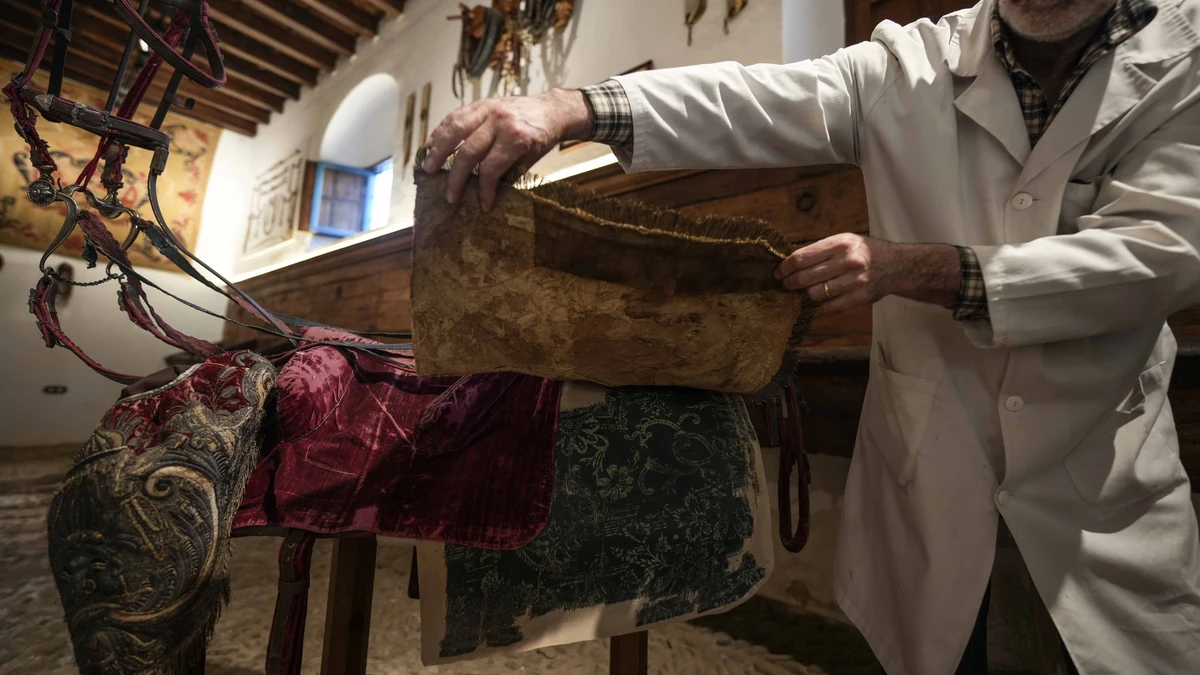
The saddle kept at the Viana Palace in Córdoba and ancestrally attributed to Boabdil never belonged to the last sultan of the Nasrid kingdom of Granada and is a work of Moorish craftsmen from Córdoba, made in the 16th or 17th century. This was concluded in a work by the art historian Francisco Durnes Sabán (Lucena -Córdoba-, 1958), in collaboration with the working group that catalogs and studies the funds of the monument managed by the Cajasur Foundation and which the Junta de Andalucía describes as “one of the most representative examples of Andalusian civil architecture”, which houses important collections of various kinds inside.
“At first I wasn’t very interested in it because “We didn’t find enough basis to get something substantial.”Durnes, with a degree in accounting and financial analysis, a degree in art history and a master’s degree in military history, told EFE. Durnes devotes a good part of his early retirement to the study of the uncatalogued pieces of the Palace of Viana, approximately 3,000, in collaboration with the working group coordinated by Francisco Manuel Carmona Carmona, doctor in art history and professor- tutor at the UNED Associated Center of Córdoba.
Carmona, promoter with his students of the group, is the one who commissions the works and, after a first analysis of the six canvases which represent the different battles in which the Spanish Tercios participated during the Thirty Years’ War, entrusts Durnes with the study of the chair attributed to Boabdil. Written references to the Sultan of Granada were void. Beyond the fact that “both on the sign and on the guides who pass by say that it is Boabdil”, only one documentary reference referred to the Nasrid king and was not supported by historical rigor.
This is an allusion that a former palace official, Joaquín Moreno Manzano, made in a guide to the monument published in 1989, attributing that the chair belonged to the last Nasrid sultan of Granada because “people want it she is from Boabdil.” It was necessary to use reliable sources and chance led the working group to find in the Archives of the Palace of Viana, another of the jewels of the building, a 19th century copy of the will that in 1516 the guardian of the Donceles had granted in favor of his second brother, Pedro Fernández de Córdoba, who was a member of the Order of Santiago and Commander of Córdoba.
The importance of this discovery was crucial to the investigation since “when Boabdil was taken prisoner during the Battle of Lucena in 1483, kings Isabella and Ferdinand granted him both the trousseau and the weapons for having taken the king of Grenade”. “Boabdil’s clothes and the weapons given to him in gratitude for the feat he accomplished ended up inheriting the Palace of Viana,” Durnes said, since the brother of the Donceles keeper “was the founder of the House of Salares.” , which has its roots here in this Palace”.
From there, over time, the Marquise de Villaseca, who married the Marquis de Viana, bequeathed it to the Artillery Museum, at the request of her husband. In the donation document which It is preserved at the Army Museum in Toledo, dated May 22, 1906., “the chair didn’t appear either.” Dissolving the idea that it might have belonged to Boabdil, Durnes investigated what era it might have come from. The paintings of the battles of the time of the Nasrid sultan ruled out that it was from that era, so he turned to the history of the horse in Cordoba and its location in the city in 1567 by decision of Philip II of Royal Stables.
A year later, “there was a rebellion in the Alpujarras in which many Moors were expelled because they felt offended by the pragmatists and rose up against the crown of Castile.” This exodus meant that 10 percent of Córdoba’s population was Moorish and that there was “a conjunction of elements between the crafts they brought and the goldsmiths, who were created as a guild in the 16th and 17th centuries.” .
During the restoration of the chair carried out by the services of the Palace of Viana itself, it was found that the metal elements are made of silver and not “iron or bronze, as indicated in the inventory”. In this way, the theory is reinforced by the presence of elements of Islamic culture in its decoration, such as the lion, the Byzantine domes or the flowers with six petals; the use of materials brought by the Moors from the Alpujaras, like velvet; and his design, to mount the genet, on the knees, which was the way of the Muslims, and not in the bridle, the way of the Christian troops. “This chair therefore meets these requirements” which make it Moorish in manufacture, underlined the researcher.
But, in addition, “it turns out that thanks to another document” from the Viana Archives, we learn that the wife of the third Marquis of Villaseca, owner of the original part of the Palace of Viana, “he sold robes worth 1,600 escudos to a priest”. The presence, between the 15th and 16th centuries, of these harnesses, decorations that are put on horses, “is an obvious and unequivocal sign that in this house, here at the Palace, there was not one, there were several,” says Durnes. underlines.

